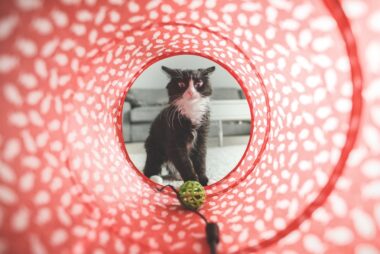Bombay Cats and Other Pets: How to Introduce Them
Introducing a new cat, such as the Bombay breed, into a home with existing pets requires careful planning. Start by observing their personalities. Every cat is different, and understanding their behavior can help in making the introduction smoother. Choose a neutral space for the initial meetings to prevent territorial conflicts. During these initial encounters, ensure that each pet has a safe retreat option available if they feel overwhelmed. It’s essential to keep the introductions gradual, allowing time for both the Bombay cats and other pets to adjust to each other’s presence. Observe their body language throughout the process to assess their comfort levels. You might also separate their living spaces initially to help prevent tension. Providing adequate resources like food, litter boxes, and scratching posts is also crucial to prevent competition. Monitor interactions and provide rewards for positive behavior. Patience is key to building trust. Over time, you may find that they develop a friendship. Ensure to continue engaging them in play activities, which encourage bonding. Ultimately, a gradual introduction will create a harmonious environment for all pets involved.
Understanding Bombay cats, with their striking appearance and playful personality, is fundamental when integrating them into homes with existing pets. They often form strong bonds, making companionship essential. Bombay cats are social and enjoy human interaction, but they can be playful with other pets, too. When introducing a Bombay cat to another pet, such as a dog, ensure the dog is well-trained and calm. They may respond positively if the dog exhibits friendly behavior. Start with short meetings in a controlled environment, perhaps using a leash for the dog. Monitor both animals closely for signs of stress or aggression. If either pet shows discomfort, separate them immediately and try again later. Gradually increase the length of these sessions as they become more comfortable. Use treats to reward positive interactions and reinforce good behavior. Ensure that both pets have their own space where they can retreat if necessary. As they become more familiar, you can start allowing more freedom during encounters. Encouraging playtime with toys can further help build a relationship. Always remember, each pet has its own pacing when it comes to acceptance and friendship.
Creating a Safe Space for All
Establishing a safe environment for all pets is crucial to a successful introduction. Create a separate area for the Bombay cat with all the necessary resources, such as food, water, and lounging spots. Keeping a designated area allows the new cat to acclimate without feeling threatened. This space helps establish confidence, as Bombay cats often need time to explore their new surroundings. Introduce familiar scents to the new space. Utilize toys, bedding, or blankets that carry the scent of the other pet to create a sense of familiarity. You can gently swap items between the pet spaces to facilitate this process. Gradually allowing the pets to explore each other’s territories can also be beneficial. Ensure each cat or pet has its own resources to avoid conflict, which is crucial for reducing stress levels associated with territorial disputes. Monitor interactions closely to prevent any aggressive behavior that may arise. Keeping sessions short initially and gradually lengthening them as they adjust will help establish comfort and trust. The introduction period can take days or weeks, so patience will lead to a harmonious coexistence.
Regular social interactions play a vital role in how Bombay cats adapt to other pets. Engaging them in interactive play, especially with toys designed for multiple pets, enhances social bonding. Popular toys for encouraging engagement include feather wands and laser pointers. These activities not only help with energy release but also foster cooperative play. Always supervise play sessions, especially with new pets, to ensure safety and prevent possible skirmishes. It’s also beneficial to maintain positive reinforcement techniques to encourage friendly interactions. Physical rewards, such as treats or additional playtime, reinforce desirable behaviors that promote friendship. If any signs of aggression or anxiety arise, don’t hesitate to separate the pets and resume at a slower pace. Give them time apart while they readjust. This way, you will significantly lower stress levels in both pets. Finally, consider scheduling regular routines for feeding and playtime that include all pets involved. This schedule plays a fundamental role in establishing a sense of normalcy and security within the household, enabling a peaceful coexistence between the new Bombay and other pets. Understanding their interactions benefits the dynamics of your entire home.
Understanding Body Language and Behavior
Recognizing the body language of both the Bombay cat and other pets is crucial during their introductions. Familiarizing yourself with their signals can help avert potential conflicts. For instance, a cat’s tail position can indicate mood—an upright tail often signifies confidence, while a lowered tail can express fear or submission. Alongside tail positions, observe their ears; flattened ears might indicate anxiety or aggression. The Bombay cat, known for its outgoing personality, may attempt to engage by rubbing or vocalizing, indicating a desire for interaction. Conversely, if the other pet displays signs of discomfort or aggression, it’s best to intervene. Positive signs include relaxed body posture and gentle purring, which signal a willingness to engage. Encouraging calm and positive interactions can gradually develop trust. If you notice a standoff or stares between pets, redirect their attention with toys. Stressful behaviors should be addressed promptly by ensuring each pet has enough space to retreat and relax on their own. Keeping interactions positive and light-hearted, while adjusting your strategies based on their unique behaviors, is critical for a successful introduction.
Once both the Bombay cat and existing pets start to get used to each other, keeping up with the relationship is essential. Routine check-ins help ensure harmony within the home. Observe how they interact during their daily lives to continue fostering a peaceful environment. If you notice jealousy or aggression arising again from either pet, it might require revisiting the introduction techniques. Dedicating special attention to each pet, such as one-on-one playtime, maintains balance. Ensure that no pet feels neglected, as this can lead to resentment. Seek ways for them to engage positively, either through shared toys or synchronized feeding times while separated. Shared activities help them bond too, paving the way for a meaningful relationship. Additionally, integrating shared routines can strengthen their connection. Feed them in proximity to each other, gradually reducing the distance over time, ensuring there are no disputes. Consistent behavior from the owner, coupled with reassurance during interactions, will make both pets more comfortable. Enjoy watching them grow together, and appreciate the unique bond that forms over time through patience and love.
Common Challenges and Solutions
Introducing a Bombay cat to other pets can pose unique challenges, but knowing common issues leads to effective solutions. Territorial disputes often arise as cats are inherently territorial animals. If a Bombay cat seems aggressive, providing a separate space can help alleviate tensions. Ensure there are enough resources available so that each pet feels secure. Introducing a feliway diffuser may help, as it can reduce stress through calming pheromones. Additionally, some pets may be more timid; it’s crucial to monitor the dynamics closely. Create an environment where timid pets can feel safe to explore or retreat without pressure. Delving into their daily interactions means you may notice patterns over time. Redirect negative behaviors by providing distractions, such as toys or treats. For those skirmishes that can’t be avoided, assess any potential triggers that cause stress, adjusting environments to mitigate these factors. Patience is vital along every step, as introducing a new companion takes time. Keep the atmosphere calm and stress-free, ensuring each pet’s emotional needs are met, leading to a serene household environment. Over time, successful adjustments will result in a harmonious home filled with joy and companionship.
The wrap-up stage is vital as it emphasizes the successful integration of a Bombay cat into a home with other pets. Consistent reviewing of interactions reinforces positive behaviors and relationships. It’s essential to continue observing how the pets communicate with each other, responding to any change in behavior promptly. Maintain a balanced routine that supports interaction, including setup playdates and separate, personal space for each pet. Celebrate small victories as they become friends, as these moments boost confidence in their journeys. Updates to the home environment should reflect current needs and preferences of all pets. Gradually incorporating the new cat into daily activities will help in further cementing their relationships. Always use gentle reinforcement, encouraging play while addressing any lingering fears. A successful introduction leads to an environment filled with love, laughter, and companionship. With time and effort, the Bombay cat and other pets will form bonds that enrich their lives. Consistent monitoring and adaptation are key, ensuring a peaceful and harmonious household. Allow newfound relationships to flourish in a loving environment, filled with understanding, patience, and care. This focus on companionship fosters a joyful home for everyone involved.





